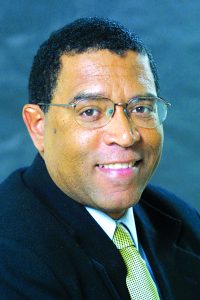#NNPA BlackPress
A Decade After Water Crisis, Art Brings Hope and Healing to Flint
SAN DIEGO VOICE AND VIEWPOINT — A decade after the water crisis began, health implications from ingesting the unsafe water as well as financial burdens continue to plague residents. Keyon Lovett, 34, a multi-disciplinary visual street artist, creatively known as The Art School Dropout, who moved back to Flint in 2021, says that while there is much rebuilding left to do, the community is also beaming with progress and hope — and that is, in part, due to Black artists in the city.
The post A Decade After Water Crisis, Art Brings Hope and Healing to Flint first appeared on BlackPressUSA.

As the community rebuilds, Black artists like Keyon Lovett are helping by promoting unity and hope.
By Nadira Jamerson, Word in Black
“Flint’s Still Fighting” is Word In Black’s series about the decade-long water crisis, and the resulting struggles and triumphs still transforming the majority-Black city.
When the water crisis hit Flint, Michigan, in 2014, residents were left with more than just contaminated pipes and brown, unsafe water flowing from their taps. The majority-Black city was also grappling with a profound lack of resources and opportunities. And as is so often the case in challenging times for the Black community, art became an outlet for expression, healing, and demanding accountability.
Ten years after the officials made the disastrous decision to switch Flint’s water supply from Detroit’s system to the Flint River to save money, Black artists are using their work to call for justice and document the city’s triumphs.
“Of course, there’s that feeling of dread because we still have a lot of dilapidated buildings and gray skies sometimes,” says Flint native Keyon Lovett, 34, a multi-disciplinary visual street artist, creatively known as The Art School Dropout. “But the hopeful thing is knowing on Friday that we have the Art Walk downtown. You can go to the Farmer’s Market and get some good food and see a show.”
Lovett didn’t plan to become an activist, but the water crisis changed the trajectory of his life. Around the time the crisis began, he left an arts program with Grand Valley State University in Allendale, Michigan, which is located two hours west of Flint near Grand Rapids. Lovett says he was unable to return home to Flint because the emergence of the water crisis meant there were few opportunities for artists in the city.
“I didn’t want to come home because the only work that would have possibly been available was working at UPS or General Motors, and my family already did that. I wasn’t trying to be the next lineage of Lovetts to be in the factory,” Lovett says.
Lovett stayed connected to what was happening in Flint through frequent trips home to visit friends and family — and what he saw began to show up in his art. In 2018, Lovett debuted “Home Sweet Home” at ArtPrize, an open, independently organized international art competition in Grand Rapids, Michigan. The live installation and accompanying documentary highlighted the realities for Flint residents during the water crisis.
“The installation I did was of me living in a house that was condemned, but I’m living off of six stacks of bottled water,” Lovett explains. “As the viewers of ArtPrize come in, they see me cooking, washing, brushing my teeth, and people would offer water because they’d see the stacks getting low. I’d say, ‘No. If I run out, I run out, because that’s how it is at home.’ That’s how it was. At the water centers, there would be days they had donations, and there would be days they don’t. People were stealing donations. People were breaking water machines.”
In the face of confusing news coverage and shame-dodging politicians who silenced many Flint residents, Lovett created the “Home Sweet Home” documentary that let Flint’s people speak the truth about the lack of access to safe and clean water.
“We filmed a short 10-minute documentary, and what I did was interview my family and friends and have them explain and share their stories on how the water crisis impacted the city, themselves, work, and everyday life,” Lovett says.
10 Years Later
A decade after the water crisis began, health implications from ingesting the unsafe water as well as financial burdens continue to plague residents. Lovett, who moved back to Flint in 2021, says that while there is much rebuilding left to do, the community is also beaming with progress and hope — and that is, in part, due to Black artists in the city.
“One of the reasons I moved back home is because of the renaissance of Black music, poetry, and art happening in Flint. A lot of Flint rappers, and singers, and artists are just being great. I wanted to come back home and be a part of that,” Lovett says.
In addition to his own work, Lovett says many other Flint organizations — from the Beats x Beers music tour, to Comma Bookstore & Social Club, and the creative co-op space Art At The Market — are using art to promote continued growth and healing.
Lovett and other artists in Flint follow in the footsteps of self-taught painter Clementine Hunter, who depicted plantation life through the 1800s, and renowned photographer Gordon Parks, who captured generations of movements for civil rights starting through the twentieth century. And as Octavia Butler said, “I began writing about power because I had so little.”
“It’s always important to have art that means something. Art that sheds a light and requires accountability,” Lovett says. “Even with the blight in the city, finding ways to put up murals, finding ways to have an initiative of Flint pride within the artwork, to even showcase a Flint artist, is important.”
The Future of Flint
Lovett says the water crisis briefly equalized Flint, forcing both the affluent and working-class residents to grapple with the same lack of accessible clean water. Now, he hopes the unity birthed from that shared struggle can leave Flint’s divisions behind for good as the city’s vibrant arts scene leads it into a culture of collective effort — and a brighter future.
“Just be one and leave all of the classism behind,” he says. “Just be Flint.”
The post A Decade After Water Crisis, Art Brings Hope and Healing to Flint first appeared on BlackPressUSA.
#NNPA BlackPress
Chavis and Bryant Lead Charge as Target Boycott Grows
BLACKPRESSUSA NEWSWIRE — Surrounded by civil rights leaders, economists, educators, and activists, Bryant declared the Black community’s power to hold corporations accountable for broken promises.

By Stacy M. Brown
BlackPressUSA.com Senior National Correspondent
Calling for continued economic action and community solidarity, Dr. Jamal H. Bryant launched the second phase of the national boycott against retail giant Target this week at New Birth Missionary Baptist Church in Atlanta. Surrounded by civil rights leaders, economists, educators, and activists, Bryant declared the Black community’s power to hold corporations accountable for broken promises. “They said they were going to invest in Black communities. They said it — not us,” Bryant told the packed sanctuary. “Now they want to break those promises quietly. That ends tonight.” The town hall marked the conclusion of Bryant’s 40-day “Target fast,” initiated on March 3 after Target pulled back its Diversity, Equity, and Inclusion (DEI) commitments. Among those was a public pledge to spend $2 billion with Black-owned businesses by 2025—a pledge Bryant said was made voluntarily in the wake of George Floyd’s murder in 2020.“No company would dare do to the Jewish or Asian communities what they’ve done to us,” Bryant said. “They think they can get away with it. But not this time.”
The evening featured voices from national movements, including civil rights icon and National Newspaper Publishers Association (NNPA) President & CEO Dr. Benjamin F. Chavis Jr., who reinforced the need for sustained consciousness and collective media engagement. The NNPA is the trade association of the 250 African American newspapers and media companies known as The Black Press of America. “On the front page of all of our papers this week will be the announcement that the boycott continues all over the United States,” said Chavis. “I would hope that everyone would subscribe to a Black newspaper, a Black-owned newspaper, subscribe to an economic development program — because the consciousness that we need has to be constantly fed.” Chavis warned against the bombardment of negativity and urged the community to stay engaged beyond single events. “You can come to an event and get that consciousness and then lose it tomorrow,” he said. “We’re bombarded with all of the disgust and hopelessness. But I believe that starting tonight, going forward, we should be more conscious about how we help one another.”
He added, “We can attain and gain a lot more ground even during this period if we turn to each other rather than turning on each other.” Other speakers included Tamika Mallory, Dr. David Johns, Dr. Rashad Richey, educator Dr. Karri Bryant, and U.S. Black Chambers President Ron Busby. Each speaker echoed Bryant’s demand that economic protests be paired with reinvestment in Black businesses and communities. “We are the moral consciousness of this country,” Bryant said. “When we move, the whole nation moves.” Sixteen-year-old William Moore Jr., the youngest attendee, captured the crowd with a challenge to reach younger generations through social media and direct engagement. “If we want to grow this movement, we have to push this narrative in a way that connects,” he said.
Dr. Johns stressed reclaiming cultural identity and resisting systems designed to keep communities uninformed and divided. “We don’t need validation from corporations. We need to teach our children who they are and support each other with love,” he said. Busby directed attendees to platforms like ByBlack.us, a digital directory of over 150,000 Black-owned businesses, encouraging them to shift their dollars from corporations like Target to Black enterprises. Bryant closed by urging the audience to register at targetfast.org, which will soon be renamed to reflect the expanding boycott movement. “They played on our sympathies in 2020. But now we know better,” Bryant said. “And now, we move.”
#NNPA BlackPress
The Department of Education is Collecting Delinquent Student Loan Debt
BLACKPRESSUSA NEWSWIRE — the Department of Education will withhold money from tax refunds and Social Security benefits, garnish federal employee wages, and withhold federal pensions from people who have defaulted on their student loan debt.

By April Ryan
Trump Targets Wages for Forgiven Student Debt
The Department of Education, which the Trump administration is working to abolish, will now serve as the collection agency for delinquent student loan debt for 5.3 million people who the administration says are delinquent and owe at least a year’s worth of student loan payments. “It is a liability to taxpayers,” says White House Press Secretary Karoline Leavitt at Tuesday’s White House Press briefing. She also emphasized the student loan federal government portfolio is “worth nearly $1.6 trillion.” The Trump administration says borrowers must repay their loans, and those in “default will face involuntary collections.” Next month, the Department of Education will withhold money from tax refunds and Social Security benefits, garnish federal employee wages, and withhold federal pensions from people who have defaulted on their student loan debt. Leavitt says “we can not “kick the can down the road” any longer.”
Much of this delinquent debt is said to have resulted from the grace period the Biden administration gave for student loan repayment. The grace period initially was set for 12 months but extended into three years, ending September 30, 2024. The Trump administration will begin collecting the delinquent payments starting May 5. Dr. Walter M. Kimbrough, president of Talladega College, told Black Press USA, “We can have that conversation about people paying their loans as long as we talk about the broader income inequality. Put everything on the table, put it on the table, and we can have a conversation.” Kimbrough asserts, “The big picture is that Black people have a fraction of wealth of white so you’re… already starting with a gap and then when you look at higher education, for example, no one talks about Black G.I.’s that didn’t get the G.I. Bill. A lot of people go to school and build wealth for their family…Black people have a fraction of wealth, so you already start with a wide gap.”
According to the Education Data Initiative, https://educationdata.org/average-time-to-repay-student-loans It takes the average borrower 20 years to pay their student loan debt. It also highlights how some professional graduates take over 45 years to repay student loans. A high-profile example of the timeline of student loan repayment is the former president and former First Lady Barack and Michelle Obama, who paid off their student loans by 2005 while in their 40s. On a related note, then-president Joe Biden spent much time haggling with progressives and Democratic leaders like Senators Elizabeth Warren and Chuck Schumer on Capitol Hill about whether and how student loan forgiveness would even happen.
#NNPA BlackPress
VIDEO: The Rev. Dr. Benjamin F. Chavis, Jr. at United Nations Permanent Forum on People of African Descent
https://youtu.be/Uy_BMKVtRVQ Excellencies: With all protocol noted and respected, I am speaking today on behalf of the Black Press of America and on behalf of the Press of People of African Descent throughout the world. I thank the Proctor Conference that helped to ensure our presence here at the Fourth Session of the […]

Excellencies:
-

 Activism4 weeks ago
Activism4 weeks agoOakland Post Endorses Barbara Lee
-

 Activism3 weeks ago
Activism3 weeks agoOakland Post: Week of April 2 – 8, 2025
-

 #NNPA BlackPress3 weeks ago
#NNPA BlackPress3 weeks agoTrump Profits, Black America Pays the Price
-

 Activism2 weeks ago
Activism2 weeks agoOakland Post: Week of April 9 – 15, 2025
-

 #NNPA BlackPress3 weeks ago
#NNPA BlackPress3 weeks agoHarriet Tubman Scrubbed; DEI Dismantled
-

 #NNPA BlackPress3 weeks ago
#NNPA BlackPress3 weeks agoTrump Targets a Slavery Removal from the National Museum of African-American History and Culture
-

 #NNPA BlackPress3 weeks ago
#NNPA BlackPress3 weeks agoLawmakers Greenlight Reparations Study for Descendants of Enslaved Marylanders
-

 #NNPA BlackPress3 weeks ago
#NNPA BlackPress3 weeks agoNew York Stands Firm Against Trump Administration’s Order to Abandon Diversity in Schools





















































